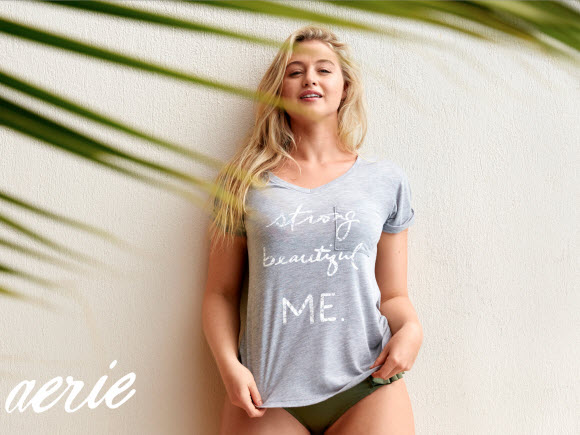For years, the underwear industry has been about selling something that appeared to be sexy, even if it wasn’t necessarily comfortable (or functional).
But earlier this week, wellness website Well+Good declared that a new category called “leisurée” is shaking up the industry. The category, which is essentially athleisure meets lingerie, was named by Michelle Cordeiro Grant, who founded Lively, a comfortable-underwear company.
Well+Good pointed to the rise of athleisure as the reason for this category’s emergence, but there’s likely another reason: The definition of what’s sexy has been steadily changing. It’s now about being comfortable — not just in clothes, but also in one’s skin, as you are.
“It’s not about your shape — it’s about the way you feel,” Ruth Bernstein, chief strategic officer at image-making agency YARD, said to Business Insider in the spring.
The most obvious leader in the “new lingerie movement” is American Eagle’s Aerie, which has seen sales soar quarter after quarter. In its most recent quarter, comparable sales spiked 24%.
In addition to selling underwear that’s functional and comfortable, Aerie has directly challenged industry norms with its Photoshop-free campaigns, which serve as a sharp contrast to Victoria’s Secret’s sometimes egregiously Photoshopped imagery. Further, its marketing is about women feeling comfortable in their own skins, as opposed to pleasing someone else. In a recent campaign, the company featured women who weren’t models, as though to prove that everyone has the right to feel sexy in any kind of underwear.
Other smaller brands have emerged as well, like Negative Underwear — which prides itself on selling functional, utilitarian underwear that’s still high quality (not flimsy cotton underwear).
“A lot of other lingerie bands seem to design products from a voyeuristic perspective, it’s for someone else’ s pleasure, not necessarily the wearer’s,” Negative Underwear cofounder Lauren Schwab told Business Insider in the fall, “and often the wearer’s the afterthought … It doesn’t matter if the wearer enjoys wearing it, as long as the person looking at her is enjoying it.”
For what it’s worth, industry behemoth Victoria’s Secret was founded by a man, in order to let men feel comfortable picking up lingerie for their significant others.
At the time, Schwab noted how wearing comfortable underwear is inherently linked to feeling good about oneself.
“And I think, from our perspective, we’re creating a brand for the woman who is wearing it … that also makes her feel proud of how her body is — [that] she doesn’t need to change it for someone else,” Schwab said.
There’s also been a crop of “period underwear” companies, like THINX, whose New York City subway campaign was almost pulled (though the brand won in the end, The New York Timesreported). These brands are clearly focused on letting women be as they are during an often uncomfortable time.
Another similar company is Dear Kate, which released imagery that directly challenged Victoria’s Secret’s notions of beauty.
Interestingly, Victoria’s Secret has been zeroing in on comfort, using padding-free bralettes, sports bras, and activewear-centric marketing to subtly target today’s consumers’ values. (Technically speaking, though, its teen brand, Pink, arguably sells more comfortable, functional lingerie than it does.)
But Pink may be a good place for the brand to look, because any trends can be linked back to what young consumers demand, and they’re certainly craving something different.
“They don’t respond to traditional notions of beauty or even sexuality,” Bernstein said in the spring. ” There is a reason that the Aerie campaigns that are not retouched are doing well. They are making a statement, changing an industry, and are still aspirational.”
And part of the statement might be putting on something that’s a little more comfortable. After all, as Grant told Well+Good, “Today’s woman is busy and running around and there’s no expectation to wear a push-up bra or show off your chest.”
Source : Business Insider

